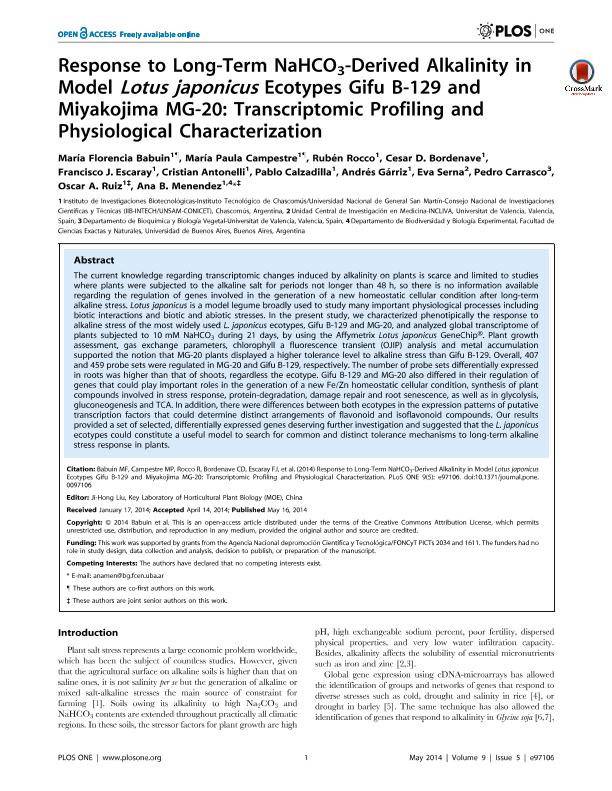Artículo
Response to Long-Term NaHCO3-Derived Alkalinity in Model Lotus japonicus Ecotypes Gifu B-129 and Miyakojima MG-20: Transcriptomic Profiling and Physiological Characterization
Babuin, María Florencia ; Campestre, Maria Paula
; Campestre, Maria Paula ; Rocco, Ruben Anibal
; Rocco, Ruben Anibal ; Bordenave, César Daniel
; Bordenave, César Daniel ; Escaray, Francisco José
; Escaray, Francisco José ; Antonelli, Cristian Javier
; Antonelli, Cristian Javier ; Calzadilla, Pablo Ignacio
; Calzadilla, Pablo Ignacio ; Gárriz, Andrés
; Gárriz, Andrés ; Serna, Eva; Carrasco, Pedro; Ruiz, Oscar Adolfo
; Serna, Eva; Carrasco, Pedro; Ruiz, Oscar Adolfo ; Menendez, Ana Bernardina
; Menendez, Ana Bernardina
 ; Campestre, Maria Paula
; Campestre, Maria Paula ; Rocco, Ruben Anibal
; Rocco, Ruben Anibal ; Bordenave, César Daniel
; Bordenave, César Daniel ; Escaray, Francisco José
; Escaray, Francisco José ; Antonelli, Cristian Javier
; Antonelli, Cristian Javier ; Calzadilla, Pablo Ignacio
; Calzadilla, Pablo Ignacio ; Gárriz, Andrés
; Gárriz, Andrés ; Serna, Eva; Carrasco, Pedro; Ruiz, Oscar Adolfo
; Serna, Eva; Carrasco, Pedro; Ruiz, Oscar Adolfo ; Menendez, Ana Bernardina
; Menendez, Ana Bernardina
Fecha de publicación:
05/2014
Editorial:
Public Library of Science
Revista:
Plos One
ISSN:
1932-6203
Idioma:
Inglés
Tipo de recurso:
Artículo publicado
Clasificación temática:
Resumen
The current knowledge regarding transcriptomic changes induced by alkalinity on plants is scarce and limited to studieswhere plants were subjected to the alkaline salt for periods not longer than 48 h, so there is no information availableregarding the regulation of genes involved in the generation of a new homeostatic cellular condition after long-termalkaline stress.Lotus japonicusis a model legume broadly used to study many important physiological processes includingbiotic interactions and biotic and abiotic stresses. In the present study, we characterized phenotipically the response toalkaline stress of the most widely usedL. japonicusecotypes, Gifu B-129 and MG-20, and analyzed global transcriptome ofplants subjected to 10 mM NaHCO3during 21 days, by using the AffymetrixLotus japonicusGeneChipH. Plant growthassessment, gas exchange parameters, chlorophyll a fluorescence transient (OJIP) analysis and metal accumulationsupported the notion that MG-20 plants displayed a higher tolerance level to alkaline stress than Gifu B-129. Overall, 407and 459 probe sets were regulated in MG-20 and Gifu B-129, respectively. The number of probe sets differentially expressedin roots was higher than that of shoots, regardless the ecotype. Gifu B-129 and MG-20 also differed in their regulation ofgenes that could play important roles in the generation of a new Fe/Zn homeostatic cellular condition, synthesis of plantcompounds involved in stress response, protein-degradation, damage repair and root senescence, as well as in glycolysis,gluconeogenesis and TCA. In addition, there were differences between both ecotypes in the expression patterns of putativetranscription factors that could determine distinct arrangements of flavonoid and isoflavonoid compounds. Our resultsprovided a set of selected, differentially expressed genes deserving further investigation and suggested that theL. japonicusecotypes could constitute a useful model to search for common and distinct tolerance mechanisms to long-term alkalinestress response in plants.
Palabras clave:
Abiotic Stress
,
Alkalinity
,
Lotus Japonicus
,
Microarrays
,
Zinc
,
Iron
,
Metal Transporters
Archivos asociados
Licencia
Identificadores
Colecciones
Articulos(CCT - LA PLATA)
Articulos de CTRO.CIENTIFICO TECNOL.CONICET - LA PLATA
Articulos de CTRO.CIENTIFICO TECNOL.CONICET - LA PLATA
Articulos(IIB-INTECH)
Articulos de INST.DE INVEST.BIOTECNOLOGICAS - INSTITUTO TECNOLOGICO CHASCOMUS
Articulos de INST.DE INVEST.BIOTECNOLOGICAS - INSTITUTO TECNOLOGICO CHASCOMUS
Citación
Calzadilla, Pablo Ignacio; Menendez, Ana Bernardina; Carrasco, Pedro; Ruiz, Oscar Adolfo; Antonelli, Cristian Javier; Serna, Eva; et al.; Response to Long-Term NaHCO3-Derived Alkalinity in Model Lotus japonicus Ecotypes Gifu B-129 and Miyakojima MG-20: Transcriptomic Profiling and Physiological Characterization; Public Library of Science; Plos One; 9; 5; 5-2014; 1-14
Compartir
Altmétricas



